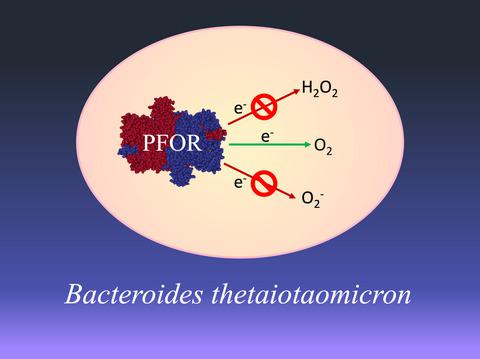当前位置:
X-MOL 学术
›
Mol. Microbiol.
›
论文详情
Our official English website, www.x-mol.net, welcomes your
feedback! (Note: you will need to create a separate account there.)
Do reactive oxygen species or does oxygen itself confer obligate anaerobiosis? The case of Bacteroides thetaiotaomicron.
Molecular Microbiology ( IF 2.6 ) Pub Date : 2020-04-17 , DOI: 10.1111/mmi.14516 Maryam Khademian 1 , James A Imlay 1
Molecular Microbiology ( IF 2.6 ) Pub Date : 2020-04-17 , DOI: 10.1111/mmi.14516 Maryam Khademian 1 , James A Imlay 1
Affiliation

|
Bacteroides thetaiotaomicron was examined to determine whether its obligate anaerobiosis is imposed by endogenous reactive oxygen species or by molecular oxygen itself. Previous analyses established that aerated B. thetaiotaomicron loses some enzyme activities due to a high rate of endogenous superoxide formation. However, the present study establishes that another key step in central metabolism is poisoned by molecular oxygen itself. Pyruvate dissimilation was shown to depend upon two enzymes, pyruvate:formate lyase (PFL) and pyruvate:ferredoxin oxidoreductase (PFOR), that lose activity upon aeration. PFL is a glycyl‐radical enzyme whose vulnerability to oxygen is already understood. The rate of PFOR damage was unaffected by the level of superoxide or peroxide, showing that molecular oxygen itself is the culprit. The cell cannot repair PFOR, which amplifies the impact of damage. The rates of PFOR and fumarase inactivation are similar, suggesting that superoxide dismutase is calibrated so the oxygen‐ and superoxide‐sensitive enzymes are equally sensitive to aeration. The physiological purpose of PFL and PFOR is to degrade pyruvate without disrupting the redox balance, and they do so using catalytic mechanisms that are intrinsically vulnerable to oxygen. In this way, the anaerobic excellence and oxygen sensitivity of B. thetaiotaomicron are two sides of the same coin.
中文翻译:

活性氧或氧气本身是否赋予专性厌氧菌?Bacteroides thetaiotaomicron 的案例。
检查了Bacteroides thetaiotaomicron以确定其专性厌氧是由内源性活性氧还是由分子氧本身强加的。先前的分析表明,在B. thetaiotaomicron中充气由于内源性超氧化物的形成率很高,因此失去了一些酶活性。然而,目前的研究表明,中枢代谢的另一个关键步骤是被分子氧本身毒害的。丙酮酸异化显示依赖于两种酶,丙酮酸:甲酸裂解酶 (PFL) 和丙酮酸:铁氧还蛋白氧化还原酶 (PFOR),它们在曝气时失去活性。PFL 是一种甘氨酰自由基酶,其对氧气的脆弱性已为人所知。PFOR 损伤的速度不受超氧化物或过氧化物水平的影响,表明分子氧本身是罪魁祸首。细胞无法修复 PFOR,这会放大损伤的影响。PFOR 和延胡索酸酶失活率相似,表明超氧化物歧化酶经过校准,因此氧敏感酶和超氧化物敏感酶对曝气同样敏感。PFL 和 PFOR 的生理目的是在不破坏氧化还原平衡的情况下降解丙酮酸,并且它们使用本质上易受氧气影响的催化机制来实现。这样,无氧优良性和氧敏感性B. thetaiotaomicron是同一枚硬币的两个面。
更新日期:2020-04-17
中文翻译:

活性氧或氧气本身是否赋予专性厌氧菌?Bacteroides thetaiotaomicron 的案例。
检查了Bacteroides thetaiotaomicron以确定其专性厌氧是由内源性活性氧还是由分子氧本身强加的。先前的分析表明,在B. thetaiotaomicron中充气由于内源性超氧化物的形成率很高,因此失去了一些酶活性。然而,目前的研究表明,中枢代谢的另一个关键步骤是被分子氧本身毒害的。丙酮酸异化显示依赖于两种酶,丙酮酸:甲酸裂解酶 (PFL) 和丙酮酸:铁氧还蛋白氧化还原酶 (PFOR),它们在曝气时失去活性。PFL 是一种甘氨酰自由基酶,其对氧气的脆弱性已为人所知。PFOR 损伤的速度不受超氧化物或过氧化物水平的影响,表明分子氧本身是罪魁祸首。细胞无法修复 PFOR,这会放大损伤的影响。PFOR 和延胡索酸酶失活率相似,表明超氧化物歧化酶经过校准,因此氧敏感酶和超氧化物敏感酶对曝气同样敏感。PFL 和 PFOR 的生理目的是在不破坏氧化还原平衡的情况下降解丙酮酸,并且它们使用本质上易受氧气影响的催化机制来实现。这样,无氧优良性和氧敏感性B. thetaiotaomicron是同一枚硬币的两个面。











































 京公网安备 11010802027423号
京公网安备 11010802027423号